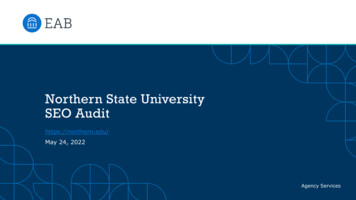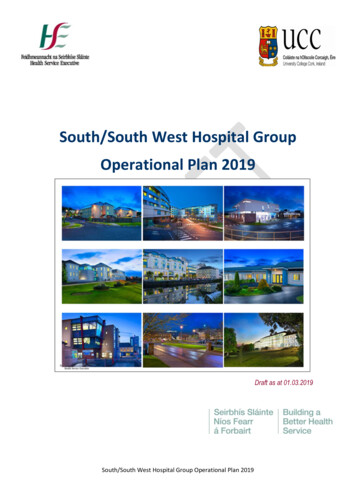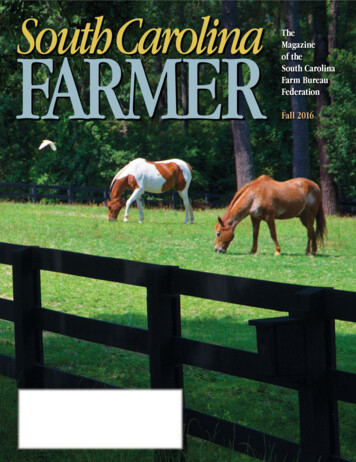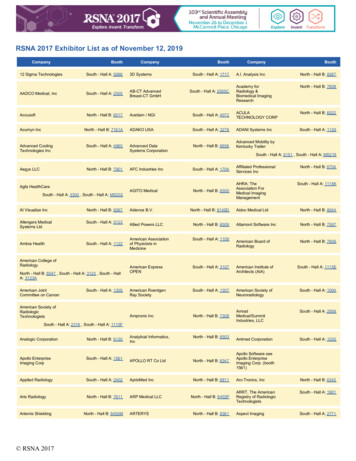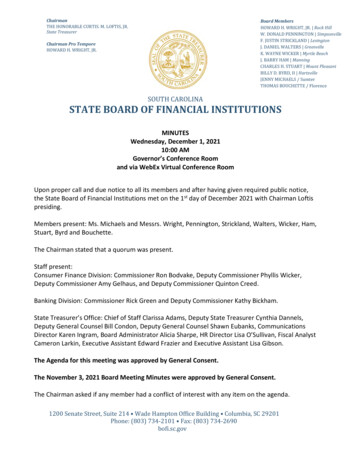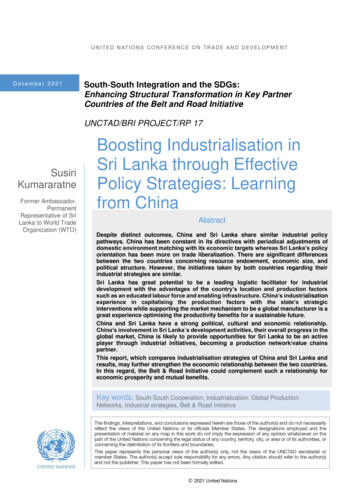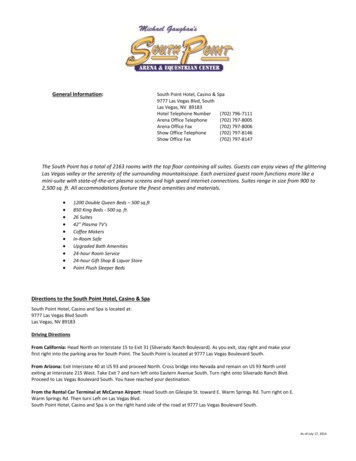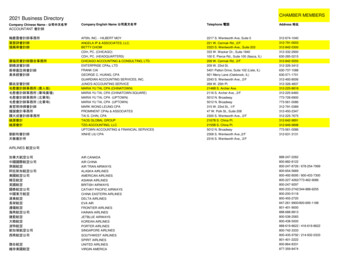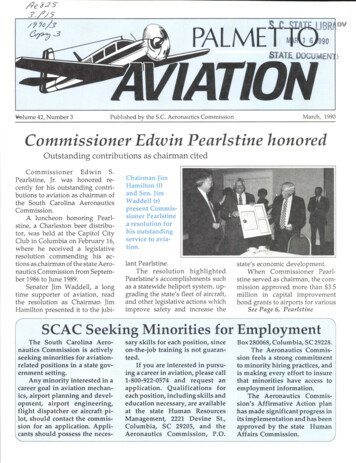
Transcription
4eE2gI?{LMETTffTilTATIONI*blume42, NumberC3Published bv the S.C. Aeronautics Commissionommis sionerEMarch, 1990dwin P e ailstine honore dOutstanding contributions as chairman citedCommissioner Edwin S.Pearlstine, jr. was honored recently for his outstanding contributions to aviation as chairman ofthe South Carolina AeronauticsCommission.A luncheon honoring Pearlstine, a Charleston beer distributor, was held at the Capitol CityClub in Columbia on February 16,where he received a legislativeresolution commending his actions as chairman of the state Aeronautics Commission from September 1986 to June 1989.Senator Jim Waddell, a longtime supporter of aviation, readthe resolution as Chairman JimHamilton presented it to the jubi-Chairman JimHamilton (l)and Sen. JimWaddell (r)present Commissioner Pearlstinea resolution forhis outstandingservice to aviation.lant Pearlstine.The resolution highlightedPearlstine's accomplishments suchheliport system, upgrading the state's fleet of aircraft,and other legislative actions whichimprove safety and increase theas a statewidestate's economic development.When Commissioner Pearlstine served as chairman, the commission approved more than 3.5million in capital improvementbond grants to airports for variousSee Page 6, PearlstineSCAC Seekirg Minorities for EmploymentThe South Carolina Aeronautics Commission is activelyseeking minorities for aviationrelated positions in a state government setting.Any minority interested in acareer goal in aviation mechanics, airport planning and development, airport engineering,flight dispatcher or aircraft pilot, should contact the commis-sion for an application. Applicants should possess the neces-sary skills for each position, sinceon-the-job training is not guaranteed.If you are interested in pursuing a career in aviation, please callt-800-922-O574 and request anapplication. Qualifications foreach position, including skills andeducation necessary, are availableat the state Human ResourcesManagement, 222L Devine St.,Columbia, SC 29205, and theAeronautics Commission, P.O.Box 280068, Columbia, 5C 29228.The Aeronautics Commission feels a strong commitmentto minority hiring practices, andis making every effort to insurethat minorities have access toemployment information.The Aeronautics Commission's Affirmative Action planhas made significantprogress inits implementation and has beenapproved by the state HumanAffairs Commission.
2 Palmetto AviationMarch,1990Calling For the Weather?Dial 1-800-WX-BriefPALMETTO AVIATION is an officialpublication of the South Canclina Aeronautics Commission. It is designed toinform members of the aviation community, and others interested in aviation, of local developments in aviationand aviation facilities, and to keep readers abreast ofnational and internationaltrends in aviation.The Aeronautics Commission is a stateagency created in 1935 by the SouthCarolina General Assembly to fosterand promote air commerce in the state.Carroll A. CampbellGovernorCommissioners:Jim Hamilton, ChairmanColumbiaRep. Olin R. Phillips, Vice ChairmanGaffneyEdwinS.Pearlsting Jr.,CharlestonDr. Crack AndersonChesterCurtis GravesDenmarkRichard McClellionAndersonRalph SchmidtGreenvilleCharles ApplebyFlorenceEx-Officio Members:Sen. IsadoreLourieColumbiaStaff:John W. HamiltonDirectorHelen F. MunnerlynEditorHave you tried calling Charleston for your flight plan? Don't doit. The Charleston weather service closed anuary 28,1990."If you don't talk to us, you don't fly," said Skeeter Gaston of theAnderson Flight Service Station. "We're it for South Carolina nowthat Charleston is closed. Anytime you want the weather you callus."Please call 1-800-WX-Brief (same as 1-800-992-7439 or if vouneed IFR clearance onlv call 1-800-621-5236.'Tips from Top Guns' improre yourAlthough thousands of book-lets, pamphlets and advisories arepublished by the FAA each year,none is as easy to read or moreinformative than one new publication."How to instantly improve youflying: Tips from Top Guns" is published by the FAA's Office of Safety.The booklet gives basic instruction on improving your flying. Oneaspect that is stressed is how a pilotcan better his skills by being moreobservant and aware of what the pilots around him are doing.flyingThe booklet stresses completepre-flight checks where no cornersare cut or assumptions are made.The publication is very readable since most of the informationquotes the best pilots around.The booklet concludes with apre-flight check list designed tohelp the pilot realize what theyshould be aware of and, whatthings, such as complacency,should be left at home.For your copy, please call yourlocal FAA Flight Standards DistrictOffice.AOPA Handbook Ready and WaitingMarch seems to the month fornew publications, and AOPA hasnot disappointed us.The new AOPA's AviationUSA is now available. This bookcombines two previous bookswhich you may be familiar with,AOPA's Airports USA andAOPA's Handbook for Pilots.The 1990 edition has more than800 pages covering hundreds oftopics, including listings of landingfacilities, and a pilot's source booksection containing federal aviationregulations.AOPA's Aviatron USA also hasa number of new items, including acomplete list of abbreviations andcontractions used by the FAA, telephone numbers for air traffic control towers, and a sunset-sunrisetable.For the first time, the book willinclude the Avionics Directory andBuyers Guide and Aircraft Performers Briefs. The 1990 edition isavailable at a cost of 524.95 forAOPA non-members.AOPA members who requestthebooks will receive one free copyand can purchase additional booksat 12.50 each.The book can be ordered bycontacting AOPA, 421 AviationWay, Frederick, Maryland, 21701,or by calling (301) 6,95-2000.South Carolina Aeronautics Commission Offices are at Columbia MetropolitanAirport. Mailing Address: Post Office Drawer 280068, Columbia, South Carolina,29228. Phone: (803) 822-5400, or 1-80G9224574.
Palmetto Aviation 3March,1990Public Meetings Slated for AirspaceOver Savannah River SiteThe Department of Transportation has proposed recently that theareas over Department of EnergyNuclear Facilities be restricted,according to a notice of proposedrules in the Federal Register.The February lS,Federal Register announced a number of publicmeetings regarding the establishment ormodification of prohibitedairspace areas for security andsafety purposes at nine DOE nu-clear weapon facilities, one ofwhich is the Savannah River Site,The public meetings in our areaMarch 15, Columscheduled arebus, OH; March 20, Oak Ridge, TN;and March 21, Augusta, GA.The March 21 meeting in Augusta will be held at the landmarkHotel, 640 Broad St., Augusta at7:30 p.m.According to the notice, themeetings will be informal and willbe conducted jointly by the FAAand DOE. Each participant will begiven an opportunity to makeapresentation. Anyone who wantsto present a position paper to thepanel regarding this topic can doso. In addition, anyone who wantsto handout pertinent position papers to the attendees should present three copies to the panel.The DOE has requested theFAA to establish or modify prohibited airspace over nine nuclearweapons facilities for security andsafety reasons.The proposed prohibited airspace would reduce the amount ofover flights around DOE facilities,thus providing the DOE securityforces increased response time toidentify an aircraft as either an intentional or accidental intruder, aswellas enhancing safety to aircraft,DOE facilities and personnelthrough avoidance of accidentsresulting from over flights.According to the notice, theproposed prohibited airspacewould set altitude surface to 10,300MSL at the Savannah River Site.CalendarMarch 18Breakfast ClubHuggins FieldTimmonsville, SCAprilBreaKast ClubAiken County AirportAprilTOpen HouseThunderbirdsCharleston AFBN. Charleston, SCAprilAn economic impact study ofSouth Carolina is underway and itneeds your help.The study which gauges theeconomic importance of aviationand aviation related industrv toSouth Carolina is being conduttedby Wilbur Smith Associates for theAeronautics Commission.Many of you have been maileda survey form from Wilbur SmithAssociates asking for informationabout your airport.An engineer with Wilbur Smithsaid that about 50 percent of thesesurveys have been returned. Butthat means that 50 percent are stillincomplete. The three-page surveyshould take about 15 minutes toanswer, according to an engineerwith WSA.Please be aware of the urgentneed to get the data back from allkey contacts to WSA.If you have passed the surveyon to someone else, follow-up soyour survey will be counted. Remember every airport survey isimportant so the most accuratedata can be obtained.After the surveys are tallied,each airport will be visited by astaff member of WSA to obtain information on the airport itself.If you have lost your survey,don't worry. Justcall Mark Counts,aviation planner Wilbur SmithAssociates, at 738-0580.T-8Blue AngelsMCAS BeaufortBeaufort, SCAprilS-14Annual Sun'N FunEAA Fly-InLakeland, FL(3't3) 644-2431AprilEconomic Impact StudyNeeds Your Survey--NOWl15Easter SundayBreakfast ClubOpen DateApril29Breakfast ClubThomson McDuffie, GAMay 4-6May-Fly'90Florence RegionalFlorence, SCMay6Breakfast ClubFlorence Regional AirportMay5Jefferson County'sThird Annual Fly-inLouisville Airport, GAMay 20Breakfast ClubLaurens County Airport
4March,1990Palmetto AviationGreenville TechnsAirc:raft Maintenance Program:Flying an aircraft is one thing,but repairing an aircraft is quiteanother thing all together.Aircraft maintenance was oncetaught at the side of an experiencedmechanic, but as the world becomes more technology oriented,so does the field of aircraft maintenance.Today, five schools in SouthCarolina have two-year associatedegree programs which bring astudent from day one to earning hisAirframe and Power Plant ratingfrom the FAA.This means that no matterwhere you're located in the state,you're near enough to earn yourA&P rating.Schools are located at TridentTech, Florence-Darlington Tech,Greenville Tech, Bob Jones University and North American Instituteof Aviation in Myrtle Beach.Most technical colleges haveabout the same curriculum, however, what differs is their involvement with the aviationcommunity.One technical college whichexcels in getting their message tothe aviation community is Greenville Tech.Their first graduatingclassboasted 100 percent placement intoaviation aircraf t maintenance positions.Greenville's students have anopportunity to learn either duringdaytime classes or during eveningsessions, with day students takingabout two years to complete coursework and evening students takingabout two and a half years.What sets this program offfrom others is the cooperation fromindustries and businesses whichemploy aircraft technicians/ especially Lockheed Aeromod, whichis located at Donaldson Center,too.At a recent advisory meeting,Matthew Hodnett of LockheedAeromod presided over an enthusiastic group of aviators intent onestablishing a scholarship fund forthe school.The scholarship is designed toassist students in the aircraft maintenance program financially and isnamed for Lockheed Aeromod inappreciation of their initial fund-servicing requirements on reciprocation and jet engine powered aircraft and helicopters.Graduates of aircraft maintenance programs are in high demand, especially professionallytrained A and P mechanics whichcan earn as much as 26,000 a year.Students enrolled in the pro-gram are required to take suchcourses as Basic Electricity, Aircraft Drawings, Fuel Systems, Engine Inspections and Propellersand Components.Doyle Arnold, Aircraft Maintenance Department Head, admittedthat these graduates have very littledifficulty in finding jobs, "Our students in our first graduating classhad 100 percent placement."He also said many studentschoose to work during the daywhile going to school at night.Arnold added that because Greenville Tech is so involved with theaircraft industries in the area, theirstudents are in high demand."Three quarter's of our firstgraduating class went to Lockheedi.g'When graduates have completed their degree at Creenville,Greenville Tech's Aircraftthey will be FAA certifiedMaintenance Technology programis actually located at DonaldsonCenter.Airframe and Power Plant mechanics able to perform maintenance, inspections, repairs andLeft, MatthewHodnett ofLockheedAeromod andDoyle Arnold ofGreenvile Techdiscuss important issues witharea businessleadersPractical experience (above) isjust one of the ways students aretaught soldering techniques at theaircraft maintenance school.
Palmetto Aviation 5March,1990Setting the P'frc'e f o,, the Best.I I I I r I r I I r I r t r I adoradesig-iquirementsof asimilarmechanical nated representative.llent (GED).l.Minimum 10th grade level in aptitna" test instrument if use in .Appticints who have .orn- l! both readingandmathportions of.Test of Adult Basic Educaitionl(rass).r.Minimum mechanical aptitude!r.o." of 50 on the Armed Services]Vocational Aptihrde Battery Test\aarrrrlrrrrrrrrrrrrrCenter. Some went to Eagle Aviation and one is an instructor withour school no'u/," said Arnold.As for enrollment, Arnold said90 students attended classes thisquarter, with about 25 shrdents attending evening class schedules.One tactic which garners brightstudents into the courses is highschool shadowing. Between six and13 students go to Greenville Tech'sprogram and get some hands-onexperience and a feel for what theprogram is like.As for a high school program/Foothills Career Center in theGreenville area has proposed tohold an aircraft maintenance classat the vocational center in the nearfuture. This will allow more students to become active in aircraftmaintenance and, perhaps, enrollin more difficult classes at a technical college.The supportof the aviationlieu of ASVAB.No physical or mental disabilitiesthat would endanger themselvesor others, (i.e. fainting, seizures,dizziness, loss of hearing, etc.)oPre-admission interview with trv is evident in the donationsthat have come from all over thestate. Not only has Stevens Aviation and Corner Stone given damaged aircraft parts to the schoolbutso has Lockheed and various otherentities.Donations are a major part ofthe learning experience at Greenville Tech and without them, manyaircraft repairs would be taughtonly in theory. All aircraft maintenance schools need used or brokenaircraft or aircraft parts so studentscan practice their repair skills.With so much support in theupstate from businesses, fixedbased operators, airports, airportmanagers and aviation officials,Greenville Tech's Aircraft Maintenance Programproves that theyare indeedpleted a military technical train- ]ing program in a mechanical ca-.reer field are exempt from taking !a mechanical aptitude test. This rtraining must be listed on their lmilitary record.Allfacets of aircraft repair aretaught as part of the two-yeardegree program. Above, this student repairs a wing of a donatedaircraft.set-ting the pace forthe best.Students learn a variety of skills needed to completetheir FAA Airframe and Power Plant licenses. Above,Pat Jarden, an instructor, teaches a pupil toubleshooting skills. At left, Jarden shows students thefiner techniques of sewing fabric to an aircraft wing.
Palmetto AviationCommissioner Pearlstine honoredContinued from Page 1Pearlstine's familywas on hand tocelebrate hisachievements.Pictured from leftare his wife Barbara, Pearlstine, hisdaughter Susan,and his son-in-law,Bruce Foster.sion and renovation of CharlestonInternational Airport with a newterminal building and a new terminal building at Beaufort CountyRep. Olin Phillips (l) readsPearlstine a plaque from theHouse of Representatives whileChairman Hamilton (r) looks on.engineering projects, includingColumbia Metropolitan Airport'srunway expansion, a major expan-Airport.Also, while chairman, the FAAapproved funding for projects totalling over 42 million for airportimprovement projects. During histenure, two new airports were established in the First CongressionalDistrictEast Cooper Airport in-IIneos Youmg @t nl[enrt VdhtemIIt eontes to FlvingFor people like Ed Young,flying isn't jwt a fun pastime, it'san exciting way to be on top ofbought an airplanea Cessna152. "I've already -sold it andbought a'182."However, flying is not the onlythings and stay active.Young, a farmer, real estatedeveloper and sometime politician is like many people wholearned to fly during WWII.thing that Young has stopped andis the- politicsother. He was oncea congressmanfor the Sixth District beating Johnlenrette in 1972. He is currentlyrunning for the House of Repre.sentatives Dist. 53 following Malloy McEachin who served for'12started againHe went through his flighttraining and then started flying P38's, P-39's and P-40's. He flew195 combat missions in the SouthPacific and received the Distinguish Flying Cross, and nine OakLeaf Clusters."After I came back from thewar," Youngsaid, "Iwent toworkas a farmer. I hadall these medals,was ranked as a major and I didn'thave enough money to buy anything, much less an airplane. abig war hero cleaning out guttersand cleaning up after cows was areal mental adjustment."He developed land for motels,Moncks Cornerand the DorchesterAirport in Summerville.The Aeronautics Commissionpresented Pearlstine a bronzeplaque naming the conferenceroom for him, and Rep. OIin Phillips, ex-officio member of Aeronautics, also presented Pearlstinewith a plaque commending hisoutstanding service to South Carolina with a special thanks from theHouse of Representatives.years.and hasa Day's Inn at I-95, Young'sPlantation Inn and a Day's Inn atSurfside Beach.He admitted that he put flyingon the back burner until somethingstruck a cord with him."I was on the advisory boardfor the Day's Inns and this fellawould come get me in his plane,"hesaid. SoonYoung was caughtupin flying again. But this time, heYoung feels that the FlorenceRegional Airport is "somethingthat can make money.passengermoney, fuel money,.all of thesemake money to pay for the airportthat's why an Authority is so important."Young has big plans forFlorence. But it's just because hislove of politics, farming, real estate and aviation have just nowmelded together completely.
Palmetto Aviation 7March,1990FYI From the FAAMmv'rt F,wc'tg'. &tfi SoEach year between one-thirdand one-half of all general aviationaccidents occur during approachand landing. Many of these accidents could be prevented by improving pilot skills and techniques, which in most cases meanschanging a few old habits. Thisis a discussion oflanding accidents causes and prevention. Some of the primarycauses of landing accidents are:a. High speed approaches andinformationtouchdowns which results in"wheelbarrowing" and/or loss ofdirectional control.b.High speed approach andtouchdown resulting in ovemrn ofthe runway.c. Delayed touchdown or landing.d. Failure to extend the landinggear before landing.e. Retracting the gear on rolIout.f. Loss of directional control.g. Striking obstructions around the landing area; i.e., wires,trees, snow drifts, crops, etc.A Few Facts About FlapsFlaps are used to vary the liftand drag characteristics of thewing. Flap extension during landings provides several advantagesby,a. Producing greater lift andallowing lower landing speed.b. Producing greater dra gt permitting a steep glide angle withoutairspeed increase.c. Reducing the landing roll.The slower landing speed andground roll results in less wear onthe brakes and tires, and yet per-mits effective directional controlof the airplane.If a swerve occurs durinq aft 8murt6.rc",,,,Ssihigh speed landing roll, the centrifugal forces or sideloads im-posed on the landing gear can ex"Eachyear b etw e enone-thi rdand one-half of all generalauiation accidents ocurr during approach and landing."ceed the aircraft design limits andresult in structural failure. Considering the safety and economic benefits , pilots should use the maximum practical flap setting for eachlanding. Slower landing speedsreduce the probability of excessivestresses due to sideloads. Considering the advantages of slowertouchdown speed, shorter landingroll, less wear and tear on brakesand tires,less strain on the landinggear components and aircraft structure and most of all-easier directional control, then why not makefull flap landing whenever practical.Flaps and CrosswindsThe use of flaps during crosswind landing is a subject often misunderstood. Some confusion results from the different statementsfound in the Aircraft Owne/sManuals, Pilot's Operating Handbooks, Airplane Flight Manualsand other publications. One manfacturer may recommend the use ofhalf flaps in crosswind situations,while another may recommend "aminimum" flap setting for thecrosswind landing in considerationof the field length.The rules governing airplanedesign require that an airplanemust be controllable in a 90 degreecrosswind with a velocity of 0.2 Vso(ref. FAR Part 23.233). Vso is defined as the stall speed in the land-ing configuration; i.e., if Vso is 50knots, 50 x 0.2 10K. In this example, the airplane must be controllable in a 10K,90 degree crosswind. Only you know your capability as a pilot, and under crosswind conditions as in other situations, you must allow a margin ofsafety. If information is not available, you can estimate the crosswind capabilities of an airplanewhile on final approach. With flapsat the desired setting, establish the"TTte useof flaps duringsszuind landing.is oftentrrisundersto o d."croslip-type crosswind correction. Ifyou are unable to maintain a runway centerline track with the fuselage aligned with the runway, thenyou do not have enough control tocope with the crosswind at thelower airspeed which will be involvedin a landing roll.Therefore, discontinue the approach. Don't risk operating inconditions exeeding your own capabilities. It is better to look for arunway with a more favorablewind condition than to riskdamaging your aircraft. While variation inapproach speed or flap setting maypermit a controlled touchdown instrong crosswind conditions, keepin mind that directional control effectiveness is reduced after landing. Also, if the airplane is forcedonto the ground at high speed,"wheelbarrowing" (rolling on thenosewheel only) may lead to direc-tional control problems and/orstructural damage.This information was obtainedfrom "Hard Facts About Softlandings"part of the FAA's Accident Prevention Program Series.
BULK RATESOUTH CAROLINAAERONAUTICS COMMISSIONP.O. Drawer 280058U.S. POSTAGEPAIDColumbia, S.C.PERMIT NO.75Columbia, 5C29228This Month. . .Inside Palmetto Aviation. Pearlstine commended for service. Gteenville's Aircraft Maintenance haven.Ed Young is still young at heart. . and much, much more!Fty with the Best -- Palmetto OneTransportation of state officialsjustisone mission of the Aeronautics Commission. Occaisionally,SCAC is fortunate enough to transport a dignitary to the state.At left, James Brady, formerpress secretary to President Reagan, was flown to Columbia viaPalmetto One and greeted by former Governor ]ames Edwards.At right, SCAC's chief pilotWalter Johnson and Brady displaytheir smiles for the camera. Bradywas inColumbia fora speech to thestate's Vocational RehabilitationDepartment.This publication is printed and distributed by the South Carolina Aeronautics Commission in theinter6st of aviation Safety and to ioster growtfr of responsible aviation in the state. The viewpointsexpressed in articles credited to specific sources are presented as the viewpoints of those writersani do not necessarily reflect the opinion of the Souih Carolina Aeronautics Commission.
Tech, Florence-Darlington Tech, Greenville Tech, Bob Jones Univer-sity and North American Institute of Aviation in Myrtle Beach. Most technical colleges have about the same curriculum, how-ever, what differs is their involve-ment with the aviationcommunity. One technical college which excels in getting their message to the aviation community is .


